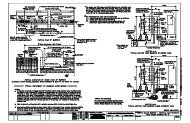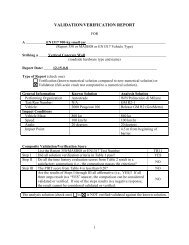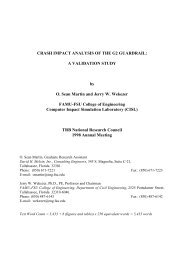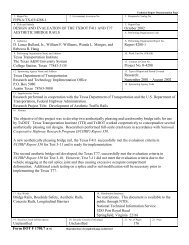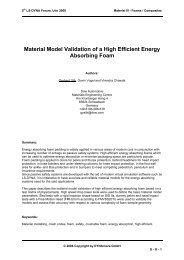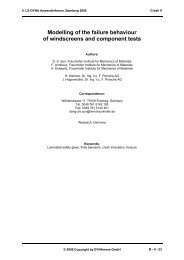Vehicle Crashworthiness and Occupant Protection - Chapter 3
Vehicle Crashworthiness and Occupant Protection - Chapter 3
Vehicle Crashworthiness and Occupant Protection - Chapter 3
Create successful ePaper yourself
Turn your PDF publications into a flip-book with our unique Google optimized e-Paper software.
Finite Element Analytical Techniques<br />
<strong>and</strong> Applications to Structural Design<br />
Schelkle <strong>and</strong> Remensperger [58] discussed the development of an integrated<br />
model of a passenger compartment <strong>and</strong> occupant using a single FE code. The<br />
model simulated a sled test by 8,700 elements in frontal crash, <strong>and</strong> included an<br />
unfolded air bag, steering system, knee bolster <strong>and</strong> seat. A 100 ms simulation<br />
required 13 CPU hours on a CRAY-2 computer. Although the model exhibited<br />
reasonable kinematics, the authors indicated that the contact algorithms were not<br />
sufficiently robust to account for interactions between the dummy arms <strong>and</strong> the<br />
deploying air bag.<br />
Khalil <strong>and</strong> Sheh [51] developed an integrated model for frontal crash. This model<br />
integrated the following components/subsystems into one FE model. These are<br />
the primary components of the model:<br />
• vehicle including a body-in-white structure of a four-door passenger sedan,<br />
• engine, transmission, etc., weighing 1,750 kg,<br />
• bucket car seat structure with the seat cushion,<br />
• nergy absorbing steering column with a steering wheel <strong>and</strong> folded air bag,<br />
• instrument panel, including a driver side knee bolster,<br />
• door structure, <strong>and</strong><br />
• Hybrid III dummy<br />
Model statistics:<br />
• 70,000 shell elements<br />
• 9,000 solid elements<br />
• 300 beam elements<br />
• 1,300 spot welds<br />
• 300 parts<br />
• 91,000 nodes<br />
• 20 contact segments<br />
Figure 3.6.4.1 shows the integrated model at time 0 <strong>and</strong> a deformed configuration<br />
at 100 ms. The model kinematics, showing vehicle deformations, air bag deployment<br />
<strong>and</strong> forward motion of the dummy <strong>and</strong> subsequent interactions with the air bag<br />
<strong>and</strong> knee bolster are qualitatively similar to a barrier test (Figure 3.6.4.2). Figure<br />
3.6.4.3 shows the energy balance for a typical run. It can be observed that the<br />
total energy remained approximately constant throughout the 100 ms duration,<br />
<strong>and</strong> the rise in internal energy <strong>and</strong> the decay in kinetic energy are smooth. This<br />
attests to very little interpenetrating among the contacted segments. The vehicle<br />
velocity response in time, at the rear rocker, is shown in Figure 3.6.4.4, along with<br />
experimental data from one test. The velocity trace agreed quite well with test<br />
data, particularly at the point where the vehicle velocity crosses the zero line.<br />
Page 145



